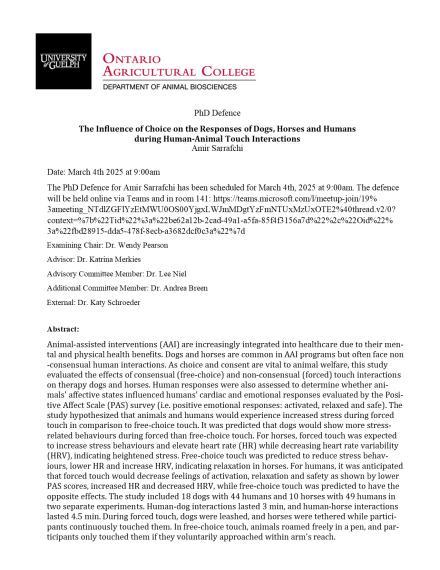Amir Sarrafchi's PhD Defence
Date and Time
Location
Room 141 and Teams: https://teams.microsoft.com/l/meetup-join/19%3ameeting_NTdlZGFlYzEtMWU0OS00YjgxLWJmMDgtYzFmNTUxMzUxOTE2%40thread.v2/0?context=%7b%22Tid%22%3a%22be62a12b-2cad-49a1-a5fa-85f4f3156a7d%22%2c%22Oid%22%3a%22fbd28915-dda5-478f-8ecb-a3682dcf0c3a%22%7d

Details
The Influence of Choice on the Responses of Dogs, Horses and Humans during Human-Animal Touch Interactions
Animal-assisted interventions (AAI) are increasingly integrated into healthcare due to their mental and physical health benefits. Dogs and horses are common in AAI programs but often face non-consensual human interactions. As choice and consent are vital to animal welfare, this study evaluated the effects of consensual (free-choice) and non-consensual (forced) touch interactions on therapy dogs and horses. Human responses were also assessed to determine whether animals' affective states influenced humans' cardiac and emotional responses evaluated by the Positive Affect Scale (PAS) survey (i.e. positive emotional responses: activated, relaxed and safe). The study hypothesized that animals and humans would experience increased stress during forced touch in comparison to free-choice touch. It was predicted that dogs would show more stress-related behaviours during forced than free-choice touch. For horses, forced touch was expected to increase stress behaviours and elevate heart rate (HR) while decreasing heart rate variability (HRV), indicating heightened stress. Free-choice touch was predicted to reduce stress behaviours, lower HR and increase HRV, indicating relaxation in horses. For humans, it was anticipated that forced touch would decrease feelings of activation, relaxation and safety as shown by lower PAS scores, increased HR and decreased HRV, while free-choice touch was predicted to have the opposite effects. The study included 18 dogs with 44 humans and 10 horses with 49 humans in two separate experiments. Human-dog interactions lasted 3 min, and human-horse interactions lasted 4.5 min. During forced touch, dogs were leashed, and horses were tethered while participants continuously touched them. In free-choice touch, animals roamed freely in a pen, and participants only touched them if they voluntarily approached within arm’s reach. During forced touch, dogs displayed more ear-back behaviour, while sniffing and avoidance of participants were more frequent during free-choice touch. Horses exhibited more oral behaviours, restlessness and tail swishing during forced touch, while head shaking occurred less often. Horses were more likely to maintain high head positions and orient their ears toward participants during forced touch. Horse HR was higher during free-choice touch than forced touch. For humans, HR was higher and HRV lower during forced touch with horses. In dog interactions, human HR, HRV and PAS scores were unaffected by touch treatments. These findings emphasize the importance of incorporating choice and agency in AAI programs to improve animal welfare and foster positive interactions between humans and therapy animals.